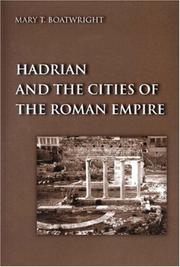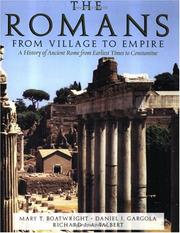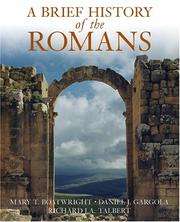| Listing 1 - 8 of 8 |
Sort by
|
Book
ISBN: 0691035881 0691002185 0691224021 Year: 1987 Publisher: Princeton Princeton University Press
Abstract | Keywords | Export | Availability | Bookmark
 Loading...
Loading...Choose an application
- Reference Manager
- EndNote
- RefWorks (Direct export to RefWorks)
The description for this book, Hadrian and the City of Rome, will be forthcoming.
Architecture --- Hadrien, --- Rome (Italy) --- Rome --- Rome (Italie) --- History --- Histoire --- 937.06092 --- History Ancient world Italy 31 B.C. - 476 A.D. Persons --- Hadrian Emperor of Rome --- -Rome --- -History --- -937.06092 --- -Architecture --- -Hadrien, --- Hadrian, --- Adrian, --- Hadrianus, --- Adriano, --- אדריאנוס, --- Hadrian --- To 476 --- Hadrian, 117-138 --- Hadrianus --- HISTORY / Ancient / Rome. --- Acqua Felice. --- Aeneas. --- Ager Vaticanus. --- Agrippa. --- Altar tombs. --- Antinoeia. --- Aventine. --- Belenus. --- Bianchini, Francesco. --- Building materials. --- Campus Martius. --- Caprae Palus. --- Clivus Victoriae. --- Compital shrines. --- Construction technique. --- Decianus. --- Decursio. --- Demeter. --- Domes. --- Drusilla. --- Eleusinian mysteries. --- Eusebia in Puteoli. --- Faustina the Elder. --- Favorinus. --- Ficus Ruminalis. --- Fornix Fabianus. --- Funeral pyres. --- Gaianum. --- Greece. --- Greek rhetoric. --- Hadrianeum. --- Hercules. --- Hunting. --- Imperial accessibility. --- Imperial banquets. --- Isantinoeia. --- Julia Domna. --- Juno Caelestis. --- Juvenal. --- Ligorio, Pirro. --- Literary disputes. --- Ludi Saeculares. --- Ludus Magnus. --- Marciana. --- Marcius, Ancus. --- Markets of Trajan. --- Meta Sudans. --- Neroneia. --- Numa. --- Obelisk of Antinoos. --- Odeum of Domitian. --- Ovile.

ISBN: 0691048894 9780691048895 0691094934 0691187215 Year: 2000 Publisher: Princeton (N.J.): Princeton university press,
Abstract | Keywords | Export | Availability | Bookmark
 Loading...
Loading...Choose an application
- Reference Manager
- EndNote
- RefWorks (Direct export to RefWorks)
Cities throughout the Roman Empire flourished during the reign of Hadrian (A.D. 117-138), a phenomenon that not only strengthened and legitimized Roman dominion over its possessions but also revealed Hadrian as a masterful negotiator of power relationships. In this comprehensive investigation into the vibrant urban life that existed under Hadrian's rule, Mary T. Boatwright focuses on the emperor's direct interactions with Rome's cities, exploring the many benefactions for which he was celebrated on coins and in literary works and inscriptions. Although such evidence is often as imprecise as it is laudatory, its collective analysis, undertaken for the first time together with all other related material, reveals that over 130 cities received at least one benefaction directly from Hadrian. The benefactions, mediated by members of the empire's municipal elite, touched all aspects of urban life; they included imperial patronage of temples and hero tombs, engineering projects, promotion of athletic and cultural competitions, settlement of boundary disputes, and remission of taxes. Even as he manifested imperial benevolence, Hadrian reaffirmed the self-sufficiency and traditions of cities from Spain to Syria, the major exception being his harsh treatment of Jerusalem, which sparked the Third Jewish Revolt. Overall, the assembled evidence points to Hadrian's recognition of imperial munificence to cities as essential to the peace and prosperity of the empire. Boatwright's treatment of Hadrian and Rome's cities is unique in that it encompasses events throughout the empire, drawing insights from archaeology and art history as well as literature, economy, and religion.
Emperors --- Patron and client --- Municipal government --- Empereurs --- Patron et client --- Administration municipale --- Biography --- Biographies --- Hadrian, --- Influence. --- Rome --- History --- Histoire --- Cities and towns, Ancient --- Cities and towns --- -Emperors --- -Patron and client --- -Clientela --- Clientelism --- Patronage, Roman --- Rulers --- Sovereigns --- Heads of state --- Kings and rulers --- Monarchy --- Global cities --- Municipalities --- Towns --- Urban areas --- Urban systems --- Human settlements --- Sociology, Urban --- Administration --- Hadrian Emperor of Rome --- -Influence --- -Cities and towns --- Administrative and political divisions. --- -Administration --- Clientela --- Adrian, --- Hadrianus, --- Adriano, --- Hadrien, --- אדריאנוס, --- Emperors - Rome - Biography --- Patron and client - Rome. --- Cities and towns, Ancient - Rome.
Book
ISBN: 9780521549943 9780521840620 0521549949 0521840627 Year: 2012 Publisher: New York: Cambridge university press,
Abstract | Keywords | Export | Availability | Bookmark
 Loading...
Loading...Choose an application
- Reference Manager
- EndNote
- RefWorks (Direct export to RefWorks)
"In this highly-illustrated book, Mary T. Boatwright examines five of the peoples incorporated into the Roman world from the Republican through the Imperial periods: northerners, Greeks, Egyptians, Jews, and Christians. She explores over time the tension between assimilation and distinctiveness in the Roman world, as well as the changes effected in Rome by its multicultural nature. Underlining the fundamental importance of diversity in Rome's self-identity, the book explores Roman tolerance of difference and community as the Romans expanded and consolidated their power and incorporated other peoples into their empire. The peoples of the Roman world provides an accessible account of Rome's social, cultural, religious, and political history, exploring the rich literary, documentary, and visual evidence for these peoples and Rome's reactions to them"--Provided by publisher
Ethnology --- Minorities --- Ethnicity --- Assimilation (Sociology) --- Acculturation --- Cultural pluralism --- Imperialism --- Anthropologie sociale et culturelle --- Minorités --- Ethnicité --- Assimilation (Sociologie) --- Diversité culturelle --- Impérialisme --- Social aspects --- Aspect social --- Rome --- Ethnic relations. --- Social conditions. --- Territorial expansion --- Relations interethniques --- Conditions sociales --- Expansion territoriale --- History --- Ethnic relations --- History. --- Territorial expansion. --- Nationale Minderheit. --- Acculturation. --- Assimilation (Sociology). --- Cultural pluralism. --- Ethnicity. --- Ethnology. --- Minorities. --- Social history. --- General --- Social aspects. --- Römisches Reich. --- Rome (Empire). --- General. --- Rome ancienne --- --Relations interethniques --- --Ethnologie --- --Minorité ethnique --- --Ethnicité --- --Assimilation, --- --Pluralisme culturel --- --Condition sociale --- --Impérialisme --- --Expansion territoriale --- --Ethnology --- Social conditions --- Minorités --- Ethnicité --- Diversité culturelle --- Impérialisme --- Ethnic minorities --- Foreign population --- Minority groups --- Persons --- Discrimination --- Majorities --- Plebiscite --- Race relations --- Segregation --- Colonialism --- Empires --- Expansion (United States politics) --- Neocolonialism --- Political science --- Anti-imperialist movements --- Caesarism --- Chauvinism and jingoism --- Militarism --- Cultural anthropology --- Ethnography --- Races of man --- Social anthropology --- Anthropology --- Human beings --- Ethnic identity --- Group identity --- Cultural fusion --- Multiculturalism --- Cultural diversity --- Diversity, Cultural --- Diversity, Religious --- Ethnic diversity --- Pluralism (Social sciences) --- Pluralism, Cultural --- Religious diversity --- Culture --- Cultural assimilation --- Socialization --- Emigration and immigration --- Culture contact --- Development education --- Civilization --- Social aspects&delete& --- Rim --- Roman Empire --- Roman Republic (510-30 B.C.) --- Romi (Empire) --- Byzantine Empire --- Rome (Italy) --- Culture contact (Acculturation) --- Ethnologie --- Minorité ethnique --- Assimilation, --- Pluralisme culturel --- Condition sociale --- Ethnology - Rome - History --- Minorities - Rome - History --- Ethnicity - Rome - History --- Assimilation (Sociology) - Rome - History --- Acculturation - Rome - History --- Cultural pluralism - Rome - History --- Imperialism - Social aspects - Rome - History --- Rome - Ethnic relations --- Rome - Social conditions --- Rome - Territorial expansion
Book
ISBN: 9780190455897 0197567037 0190455918 019045590X 9780190455903 9780190455910 9780197567036 Year: 2021 Publisher: New York: Oxford University Press,
Abstract | Keywords | Export | Availability | Bookmark
 Loading...
Loading...Choose an application
- Reference Manager
- EndNote
- RefWorks (Direct export to RefWorks)
The Imperial Women of Rome explores the constraints and activities of the women who were part of Rome's imperial families from 35 BCE to 235 CE, the Roman principate. Boatwright uses coins, inscriptions, papyri, material culture, and archaeology, as well as the more familiar but biased ancient authors, to depict change and continuity in imperial women's pursuits and representations over time. Focused vignettes open each thematic chapter, emphasizing imperial women as individuals and their central yet marginalized position in the principate. Evaluating historical contingency and personal agency, the book assesses its subjects in relation to distinct Roman structures rather than as a series of biographies. Rome's imperial women allow us to probe the meanings of the emperor's authority and power; Roman law; the Roman family; Roman religion and imperial cult; imperial presence in the city of Rome; statues and exemplarity; and the military and communications. The book is richly illustrated and offers detailed information in tables and appendices, including one for the life events of the imperial women discussed in the text. Considered over time and as a whole, Livia, the Agrippinas and Faustinas, Julia Domna, and others closely connected to Rome's emperors enrich our understanding of Roman history and offer glimpses of fascinating and demanding lives.
Marginality, Social --- Marginality, Social. --- Upper class women --- Upper class women. --- History --- Social conditions --- Rome (Empire). --- Exclusion, Social --- Marginal peoples --- Social exclusion --- Social marginality --- Assimilation (Sociology) --- Culture conflict --- Social isolation --- Sociology --- People with social disabilities --- Women
Book
ISBN: 9780197777008 Year: 2024 Publisher: Oxford, New York : Oxford University Press,
Abstract | Keywords | Export | Availability | Bookmark
 Loading...
Loading...Choose an application
- Reference Manager
- EndNote
- RefWorks (Direct export to RefWorks)
The Imperial Women of Rome explores the constraints and activities of the women who were part of Rome's imperial families from 35 BCE to 235 CE, the Roman principate. Boatwright uses coins, inscriptions, papyri, material culture, and archaeology, as well as the more familiar but biased ancient authors, to depict change and continuity in imperial women's pursuits and representations over time. Focused vignettes open each thematic chapter, emphasizing imperial women as individuals and their central yet marginalized position in the principate. Evaluating historical contingency and personal agency, the book assesses its subjects in relation to distinct Roman structures rather than as a series of biographies. Rome's imperial women allow us to probe the meanings of the emperor's authority and power; Roman law; the Roman family; Roman religion and imperial cult; imperial presence in the city of Rome; statues and exemplarity; and the military and communications. The book is richly illustrated and offers detailed information in tables and appendices, including one for the life events of the imperial women discussed in the text. Considered over time and as a whole, Livia, the Agrippinas and Faustinas, Julia Domna, and others closely connected to Rome's emperors enrich our understanding of Roman history and offer glimpses of fascinating and demanding lives.

ISBN: 0195118758 0195118766 0198027974 1280471204 1602562652 Year: 2004 Publisher: New York : Oxford University Press,
Abstract | Keywords | Export | Availability | Bookmark

ISBN: 0195187156 0195187148 Year: 2006 Publisher: New York Oxford Oxford University Press
Abstract | Keywords | Export | Availability | Bookmark
 Loading...
Loading...Choose an application
- Reference Manager
- EndNote
- RefWorks (Direct export to RefWorks)
Book
ISBN: 9780199730575 Year: 2012 Publisher: Oxford [etc.] Oxford University Press
Abstract | Keywords | Export | Availability | Bookmark
 Loading...
Loading...Choose an application
- Reference Manager
- EndNote
- RefWorks (Direct export to RefWorks)
| Listing 1 - 8 of 8 |
Sort by
|

 Search
Search Feedback
Feedback About UniCat
About UniCat  Help
Help News
News